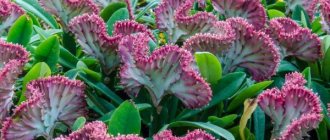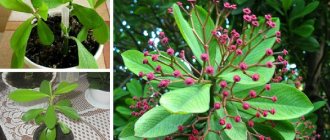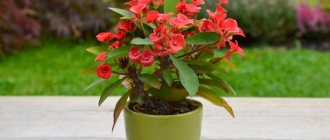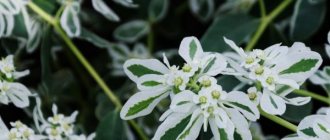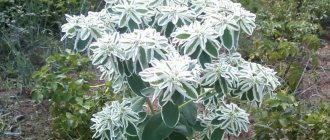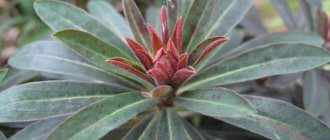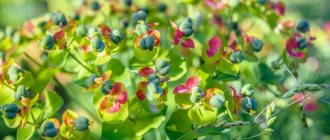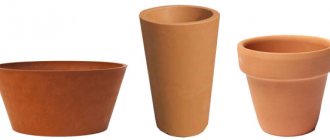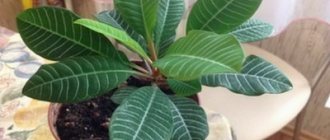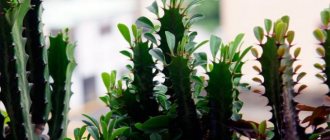Category: Succulents, Care Published 10/30/2018 · Comments: · Reading time: 8 min · Views: 1,946
Euphorbia ribbed or combed can be found in apartments, offices, shopping centers and other premises. Everywhere this plant fits perfectly into the surrounding environment and adds a little tropical flavor. Perhaps it is precisely because of this versatility and spectacular appearance that the succulent is loved by flower growers all over the world, and even its toxicity does not prevent the growth of popularity.
What is good about this tropical inhabitant and what kind of care does it require at home?
Botanical description of the plant
The flower belongs to the Euphorbiaceae family and was first discovered in natural conditions in Madagascar.
Notable for its appearance:
- stem color ranges from dark brown (bottom) to dark green (younger areas);
- has the shape of a pentagon, dotted with gray scars that smooth out as the flower grows;
- can reach 1.8–1.9 m in height;
- there are no branches on the plant;
- at the top, oval, slightly elongated leaves with red petioles are collected in a bunch;
- the upper part of the leaf plate is glossy, bright green, the lower part is lighter, almost light green, which allows the plant to absorb more light.
Important! Milkweed has a poisonous milky sap that can cause an allergic reaction to the skin.
Due to its unusual stem, milkweed looks like a member of a succulent, but the bunch of leaves at its top resembles a palm tree.
In summer, inflorescences with white and pink petals appear on red-yellow peduncles at the top of the plant. They can bloom for several months, and then fruit boxes appear in their place. When the seeds ripen in them, the fruits burst, scattering the seed around 3 m.
| Root system | Developed, fragile |
| Stem | Pentagonal, dark green with scars |
| Leaf Shape | Extended oval |
| Leaf color | Light green |
| Flower shape | Cup-shaped |
| Flower color | White, pink |
| Fruit shape | Boxes |
| Fruit color | Dark brown |
Medicinal properties and harm
Euphorbia received its name from the ancient Greek physician Euphorbus, who was the first to use the milky sap of the plant as medicine.
- The plant is still used today in the treatment of the following problems:
- infusion of leaves is used in the fight against age spots, dry calluses, warts, and fungus;
- a decoction of the roots treats diseases of the stomach and liver;
- in homeopathy it is used as an analgesic and laxative;
- the milky juice of the flower is part of healing, rejuvenating preparations;
- in modern pharmacology it is a component of drugs for cystitis and hemorrhoids.
Did you know? Feng Shui experts recommend keeping milkweed in your home to attract positive energy and harmony.
- As with any medicinal plant, you must be careful with milkweed:
- Pregnant or lactating women should not use products containing leaves or juice of this plant;
- contact of juice with skin and mucous membranes provokes allergic reactions;
- consumption causes burns of the oral cavity, gastrointestinal tract, as well as nausea and vomiting;
- Exceeding the dose of a milkweed-based drug can lead to blindness and even death.
Conditions for growing at home
It is distinguished from succulents and palm trees, which the ribbed spurge is so similar to, in its unpretentiousness to the conditions necessary for development.
Lighting
It will be comfortable for the flower to be placed in places where there is diffuse lighting. Excess light causes burns on its leaves, and the trunk becomes covered with a dark protective shell. A long stay in a place without sufficient light leads to leaf fall. To avoid this, add artificial lighting.
Important! If you are looking for a plant to place in the back of the room, then spurge is not the best option: after 2
–
After 3 weeks it will begin to lose leaves due to lack of light.
Ventilation
The flower loves fresh air, so in the warm season it is useful to take it out onto an open balcony or into the garden. In room conditions, periodic ventilation is provided, avoiding drafts, which are detrimental to the plant.
Temperature
Coming from the tropics, milkweed needs warmth. In summer, the optimal range for it will be +20...+25°C, and in winter it is necessary to ensure a temperature of at least +16°C. If the room is cold, the plant's growth will slow down. Excessive heat causes leaves to wither and fall off.
Air humidity
All species of this family tolerate dry air well, but spraying is also useful for them. During the procedure, dust is removed from the plant and prevention occurs against pests that love overdried leaves.
Diseases and pests
- The stems are stretched, the leaves become smaller - insufficient lighting.
- The leaves droop and fall off - the soil is drying out.
- Leaves turn yellow and fall off - waterlogging or sudden temperature changes, drafts.
Excessive humidity causes rot. Root rot is especially dangerous.
In case of severe damage, the healthy apical part should be cut off, rooted and maintained in suitable conditions, and the rest of the plant should be eliminated.
If there are not enough nutrients, space and light, and moisture stagnates, powdery mildew affects the spurge.
Such a plant is isolated and treated with fungicidal preparations and copper sulfate solution.
In the future, conditions of detention will be optimized.
Aphids or red spider mites may settle on the leaves of a weakened plant. Affected areas should be treated immediately.
You can use a soap solution, but the most effective remedy against such pests is systemic insecticides.
The underground part of milkweed can be attacked by root mealybugs. If this happens, the roots are washed and the ground is treated with a soil insecticide.
How to care at home?
The unpretentiousness of milkweed is also evident in its care. You won't have to spend a lot of time on this flower, but some features require attention.
Did you know? According to popular beliefs, if you do not provide the milkweed with proper care, all its positive impact on family well-being turns into a negative one.
Watering
The beautiful appearance of the plant directly depends on proper watering. To moisten the milkweed soil, use soft, well-settled water at room temperature.
In summer, the flower is watered 1-2 times a week, and in particularly hot periods this can be done every day, accompanying the procedure with spraying. In autumn, the amount of watering is reduced to once a week; in cold weather, it is enough to moisten the soil 1-2 times a month.
Irrigate milkweed at the root so that water does not stagnate on the leaves, causing various diseases.
Top dressing
In autumn and winter, when milkweed has a dormant period, fertilizers are not applied. But during the period of flowering or active growth in spring and summer, you cannot do without fertilizing. It is advisable to feed the ribbed spurge every week using complexes for cacti and succulents. It is possible to use universal fertilizers for indoor plants, but they will have to be diluted twice as weak as indicated in the instructions.
Important! Potassium supplements are especially useful for milkweed during the flowering period.
Crown trimming
Milkweed will not be harmed by pruning as soon as the flowers wither. They must be removed along with dry cuttings and yellowed leaves so as not to spoil the beautiful crown of the plant.
Transfer
The flower is replanted infrequently, once every 2–3 years, but it must be done in the spring.
There are no special requirements for containers; you just need to take a pot larger than the previous one and with a hole for water drainage. Place expanded clay or small pebbles with charcoal on the bottom of the flowerpot for high-quality drainage and prevent root rot.
Since spurge naturally grows in sandy soils, ready-made substrates for succulents or cacti are suitable for home plants. You can prepare the soil for the plant yourself.
To do this, take in equal parts:
- leaf soil;
- peat;
- sand.
Replant carefully so as not to damage the root system of the milkweed. Typically, gardeners re-transfer the plant by transferring the old earthen ball into a new pot, supplementing it with fresh substrate. After this, water the plant moderately and leave it to “take root” in the new pot for several days.
Poisonous exotic - ribbed spurge (combed)
Indeed, the long “trunk” with a bunch of widely spread petiolate leaves at the top is similar to the silhouette of a palm tree, but this resemblance is purely external.
Euphorbia ribbed, also called comb or comb-ribbed, belongs to the large family of plants with poisonous milky sap - Euphórbia, Euphorbia.
The pentagonal dark green stem with gray scars, usually without branches, is crowned with a tuft of large, elongated oval, bright green, glossy leaves with reddish petioles.
The underside of the leaves is very light; it serves as a reflector and additionally illuminates the foliage with sunlight.
On the lower, browning part of the stem, the edges smooth out and disappear.
In the summer, starting from the first year of life, the plant blooms, forming apical inflorescences of several flowers - each with two white or pink “petals”-bracts.
Next you can see the ribbed (crested) spurge:
To successfully care for Euphorbia ribbed (crested) at home, the following conditions must be met:
Comb spurge is light-loving, but intense and prolonged solar irradiation does not benefit it: the plant gets burned on the leaves and grows a protective cover of coarse brown tissue on the stem-stem.
To maintain the attractive exotic appearance of this milkweed, you should place it in an east or west facing window.
On the south side, mandatory shading will be required, and on windows in the northern directions, additional lighting will be required.
Temperature
For a native of the tropics and subtropics, the optimal temperature range in summer is 20-25 degrees, in winter – about 16 degrees.
Such a decrease in temperature will ensure a slowdown in growth and the milkweed will not stretch in conditions of reduced winter light.
In summer, it is very useful to place the plant on the balcony, providing it with protection from excessively long sunbathing and strong winds.
In the habitats of the comb-rib milkweed, sandy soils are common, not too saturated with nutrients, and in indoor culture soils for cacti and succulents are suitable for it: loose, slightly acidic, moderately nutritious.
You can also mix equal amounts of leaf soil, peat and sand, or prepare a substrate containing two parts humus, one part leaf soil, two parts sand and one part peat.
Landing, transplant
When planting ribbed milkweed, care should be taken to ensure good water drainage, since the main danger for this unpretentious Madagascan is stagnation of moisture in the soil, leading to rotting of the stem and root system.
A drainage layer – expanded clay or small pebbles – must be placed at the bottom of the planting container.
You can also add pieces of charcoal.
When planting milkweed, special attention is paid to the root system: it should not be damaged or become waterlogged.
Therefore, if possible, the old soil on the roots is preserved and the first days after planting the plant is watered moderately, according to the season.
If you have purchased milkweed and it is in a shipping container, it should be immediately transplanted into a container of a suitable size, ensuring good drainage and maintained in accordance with the time of year at which the transplant occurred.
In spring and summer, water the plant relatively abundantly, from one to two times a week, with soft, well-settled water at room temperature.
In autumn, watering is reduced, and in winter, at slightly lower temperatures, comb spurge is watered to prevent the soil from drying out: once or twice a month.
If the winter is warm, you will need to water more often.
Air humidity
Ribbed milkweed, as a typical representative of its genus, tolerates dry air well, however, it also benefits from water treatments - infrequent spraying, which washes away dust from the leaves and stem, and also creates an obstacle to attacks by insect pests: many of them are more willing to settle on a dry surface plants.
During the spring-summer period of active growth, comb-ridged milkweed needs weekly feeding.
Read also: The main reasons why irises do not bloom
It is best to use special compounds for cacti and succulents.
Ready-made mixtures for indoor plants can also be used, but before feeding the plant, they must be strongly diluted.
This spurge responds well to the increased potassium content in the fertilizing.
Euphorbia does not require special conditions to bloom and, if it is light, warm and not too humid, it willingly, starting from the first year of life, forms pretty pink or white inflorescences on reddish or yellowish-green peduncles in the upper part of the stem.
Seeds set easily; after ripening, the plant scatters them from the ripened boxes in all directions a meter away from itself.
Seed germination is also good.
Reproduction
Ribbed spurge can be propagated by cuttings and seeds.
Cuttings
With this method of propagation, it is necessary to take into account that this type of milkweed is reluctant to branch, and therefore, if you cut off the top of the mother plant into a cutting, it will lose its decorative effect.
For this reason, propagation by cuttings is rarely used, in special cases - for example, if a plant is affected by root rot and its healthy top needs to be saved.
The top is cut off, the milky juice is allowed to drain, and the cut is sprinkled with charcoal powder.
The resulting cutting is withered for 2-3 days in the shade and planted for rooting in a moist soil mixture of a lightweight composition: sand and peat in equal proportions.
Ribbed milkweed seeds have excellent germination capacity and germinate abundantly in all pots adjacent to the plant.
Such self-seeding even has to be limited.
For targeted, controlled sowing, collected ripened seeds are placed on the soil surface and covered with glass.
Shoots appear quickly. Soon the young plants can be planted and cared for as if they were fully grown: watered, fed, transferred to larger pots.
By next summer they will reach a height of 15 cm and bloom for the first time in their lives.
Reproduction
In nature, spurge spreads by means of seeds, which scatter in all directions from fruit boxes. Flower growers prefer to propagate this flower using cuttings and division in order to quickly obtain an adult plant.
Cuttings
To obtain a cutting, the top of the plant is cut off, because it does not have separate branches. After separating the cuttings, the mother flower loses its decorative effect until it grows a new crown, which is why not many gardeners practice this method. But it is actively used in cases of root rotting, when there is a need to save a healthy crown by replanting it with a separate plant. The best time for cuttings is July.
The breeding process is simple:
- Carefully separate the top from the stem.
- Allow the milky juice to drain from the future cutting.
- The cut area is treated with charcoal.
- The cuttings are left in the shade for 2–3 days.
- After the specified time, the seedling is dipped into a damp mixture of peat and sand to form a root system.
- When new roots entwine a lump of substrate, this is a signal that the cutting is ready to be planted in the soil of the pot.
By division
By dividing the bush, the flower is replanted in March-April or September. But they rarely do this.
Important! The division method causes stress for the plant, so after such a transplant it will take a year or two for it to restore active growth and begin to bloom.
The procedure consists of several steps:
- Remove the plant from the pot.
- Carefully inspect its roots for rot. If there are such areas, then carefully cut them and sprinkle the cut areas with charcoal, otherwise the roots will continue to deteriorate.
- After this, divide the root tuber. Try to do this without scissors, separating the thin shoots by hand.
- Sometimes you can’t do without cutting off the roots, so carefully treat the cutting surfaces of the knife or scissors with an antiseptic, and only then carry out the “operation.”
- Wash the cut areas with warm water, it will stop the milky juice, then treat the resulting wounds with charcoal.
- The resulting part of the root ball can be immediately planted in a new pot.
Difficulties in growing
Although ribbed milkweed is unpretentious, sometimes the following problems arise when growing it:
- The plant stretches upward unnaturally quickly, and the leaves on it grow smaller than usual - there is not enough light and you need to move the pot with the plant to another place.
- The flower drops its leaves, and then drops them - there is a lack of moisture, watering must be increased, otherwise there is a risk of ruining the plant.
- The leaves first turn yellow and then fall off - excess moisture or sudden temperature changes in the room. Try drying the milkweed for a few days or moving it to a different location.
- Root rot is an excess of moisture. If it has affected the plant, then there is no other choice but to cut off the green top and replant it as a cutting.
- Powdery mildew - appears when care rules are not followed for a long time (lack of fertilizing, lack of space, lack of light, stagnation of water). You can recognize the disease by the white coating on the leaves, which over time become overgrown with brownish fruits with fungal spores. Milk whey (in an aqueous solution of 1:10), which is used to treat the leaves, or chemicals (“Fundazol”, “Topaz”, “Amistar”) will help to cure euphorbia.
- Aphids or spider mites may settle on the flower. They love weakened plants, so make sure that the milkweed has enough nutrients. The appearance of aphids is indicated by small white insects and holes on the leaves from their vital activity. A tick can be easily recognized by its thin sticky web. Washing with soapy water and spraying with citrus infusion (pour 100 g of orange or lemon peels with water and leave for 3 days in a warm room) will help get rid of pests. If there are too many insects, then use insecticides (“Aktellik”, “Confidor”, “Neoron”).
Did you know? Popular beliefs say that spurge (like a flower with thorns) should not be placed in the bedroom so that conflicts do not arise between spouses.
Euphorbia ribbed is a common plant found in most indoor gardens. It is popular due to its exotic appearance and ease of care. In addition to decorative properties, it also has medicinal properties. With proper care, the plant will decorate any room for a long time.
Major diseases
- Excess moisture may cause rot on the roots.
- Leaves may be affected by aphids or mites; the affected areas should be treated with a special pest control solution.
- As for the roots, they can be affected by a root parasite such as mealybug. In such cases, the soil should be replaced and the roots washed.
Read also: How to pickle squash in jars for the winter: 3 recipes at home (reviews)
Ribbed spurge has an exotic appearance and is perfect for any interior in an apartment or house. The flower is not whimsical and will not take up much of your time to care for. Following simple rules will allow you to enjoy the flower for many years.

